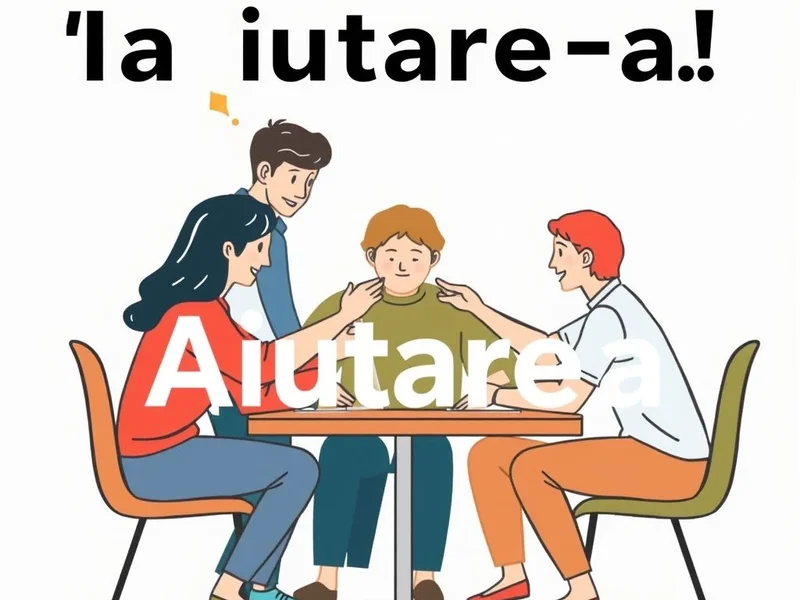How to Use "Aiutare a": Meaning and Practical Examples for Speaking Italian Naturally
Learning Italian also means mastering those little expressions that make your speech sound natural and fluent. Today we’re diving into a fundamental phrasal verb: "aiutare a". It seems simple, but using "aiutare a" correctly can be confusing, especially because of the preposition that comes with it. If you’ve ever wondered how to use "aiutare a" without mistakes or which Italian phrasal verbs you really need, you’re in the right place. In this article, we’ll explore its meaning, grammatical structure, and give you practical examples to help you communicate in Italian with confidence. Let’s clear up any doubts!

Table of Contents
- What does “Aiutare a” mean?
- The Grammatical Structure: How is it Used?
- Phrases and Examples with “Aiutare a”
- Crucial Differences: Common Mistakes to Avoid
- Similar or Related Expressions
- Conclusion
More: Aggrapparsi a Meaning and Practical Examples
What does “Aiutare a” mean?
- Literal Meaning: To provide support or assistance so that someone can carry out an action or reach a goal.
- Example: "Mio padre mi aiuta a portare le borse pesanti."
- Figurative Meaning: To contribute to the success, improvement, or development of something or someone.
- Example: "Studiare ogni giorno aiuta a migliorare il tuo italiano."
More: How to Use Aggiungere a with Practical Examples
The Grammatical Structure: How is it Used?
The most common structure for "aiutare a" is very clear:
- [Subject] + aiutare + [Person/Thing] + a + [Verb in the Infinitive]
- Example: "Ti aiuto a capire questa lezione." (Subject: implied I, Person: you, Verb: capire)
- Example: "Il riposo aiuta il corpo a recuperare energie." (Subject: rest, Thing: the body, Verb: recuperare) The use of the preposition "a" is fundamental. It serves to connect the action of "aiutare" with the subsequent action expressed by the infinitive verb. Without "a", the sentence would be grammatically incorrect in this specific context. "Aiutare" almost always requires "a" when followed by a verb indicating the action being helped with. Notice that the verb "aiutare" is a transitive verb, which means it can have a direct object (e.g., "Aiuto mio fratello"). However, when you specify the action you are helping with, the preposition "a" is necessary to introduce the infinitive verb, as in "aiuto mio fratello a studiare". This combination makes it a "phrasal verb" in common usage, even though it isn't a true phrasal verb like in English.
More: Affidarsi a: How to Use It with Meaning and Practical Examples
Phrases and Examples with “Aiutare a”
Here are some practical examples to understand how "aiutare a" is used in everyday speech.
📍 Context: Family
**Mamma:** "Hai finito i compiti? Vuoi che ti aiuti a studiare per l'esame?"
**Figlio:** "Sì, per favore! Non riesco proprio a capire questa parte."
📍 Context: Work
**Collega A:** "Questa presentazione è troppo complessa. Credo di non farcela da solo."
**Collega B:** "Dai, ti aiuto a preparare i grafici e a revisionare il testo."
📍 Context: Daily Life
**Amico A:** "Ho tantissime cose da portare in casa, ma la mia schiena fa male."
**Amico B:** "Non preoccuparti, ti aiuto a trasportare le scatole, nessun problema."
📍 Context: Health and Well-being
**Dotteressa:** "Fare attività fisica regolarmente aiuta a mantenere il cuore in salute e a ridurre lo stress."
**Paziente:** "Capisco, quindi dovrei iniziare a camminare di più ogni giorno."
Crucial Differences: Common Mistakes to Avoid
The most common mistake with "aiutare a" is omitting or misusing the preposition. Here is the difference:
Aiutare + A + Infinitive Vs. Aiutare + DI + Infinitive
Many students mistakenly use "aiutare di" when they want to express the action being helped, possibly influenced by other Italian verb constructions. "Aiutare" followed by an infinitive always requires the preposition "a".
- Correct: "Ti aiuto a cucinare la cena." (It means I help you in the process of cooking.)
- Incorrect: "Ti aiuto di cucinare la cena." (Grammatically wrong in this context.)
Aiutare + A + Infinitive Vs. Aiutare + Direct Object (without preposition)
Sometimes, "aiutare" can be followed directly by a direct object, but the meaning changes slightly or refers to a person/thing instead of an action.
- "Aiuto Marco a studiare." (Here "a studiare" specifies the action Marco is helped with. The preposition "a" is fundamental to introduce the verb.)
- "Aiuto Marco." (This means I offer general support to Marco, without specifying a particular action. Marco is the direct object.)
Understanding this distinction is crucial for precision in your Italian. If you specify what you help with, always use "a" before the infinitive. For more about Italian prepositions, you can check resources like Grammatica Treccani.
Similar or Related Expressions
Here are some expressions that can have a similar or complementary meaning to "aiutare a":
| Similar Expression | Brief Meaning | Example |
|---|---|---|
| Dare una mano | To offer help, assist | "Mi ha dato una mano a spostare il divano." |
| Dare supporto | To provide moral or practical support | "Dare supporto ai colleghi è importante." |
| Contribuire a | To make a contribution, participate in the result | "Tutti hanno contribuito a organizzare la festa." |
| Facilitare | To make it easier, facilitate a process | "Il nuovo software facilita il nostro lavoro." |
Conclusion
To sum up, "aiutare a" is an essential phrasal verb for Italian learners, indicating the providing of assistance with a specific action, always requiring the preposition "a" followed by an infinitive. Mastering "aiutare a" will allow you to express yourself more precisely and naturally. Now it’s your turn! Try creating a sentence using "aiutare a" in the comments below. How is Italian "aiutando a" help you grow?